Travel and Tourism Report: System04104, Future Challenges
VerifiedAdded on 2023/04/06
|13
|3601
|390
Report
AI Summary
This report analyzes the travel and tourism industry, focusing on four key emerging themes: company culture/work environment, innovation/technology, sustainability/market relevance, and customer experience. It examines how technological advancements, particularly in information technology and social media, are reshaping the industry, impacting job roles, and influencing customer behavior. The report explores the importance of sustainability, encompassing environmental, economic, and socio-cultural dimensions, and their impact on the industry's growth. It also discusses future challenges, including the need for adaptation to changing customer expectations and the impact of rising Asian populations on tourism trends. The report concludes with recommendations for the industry to navigate these challenges and ensure future growth.
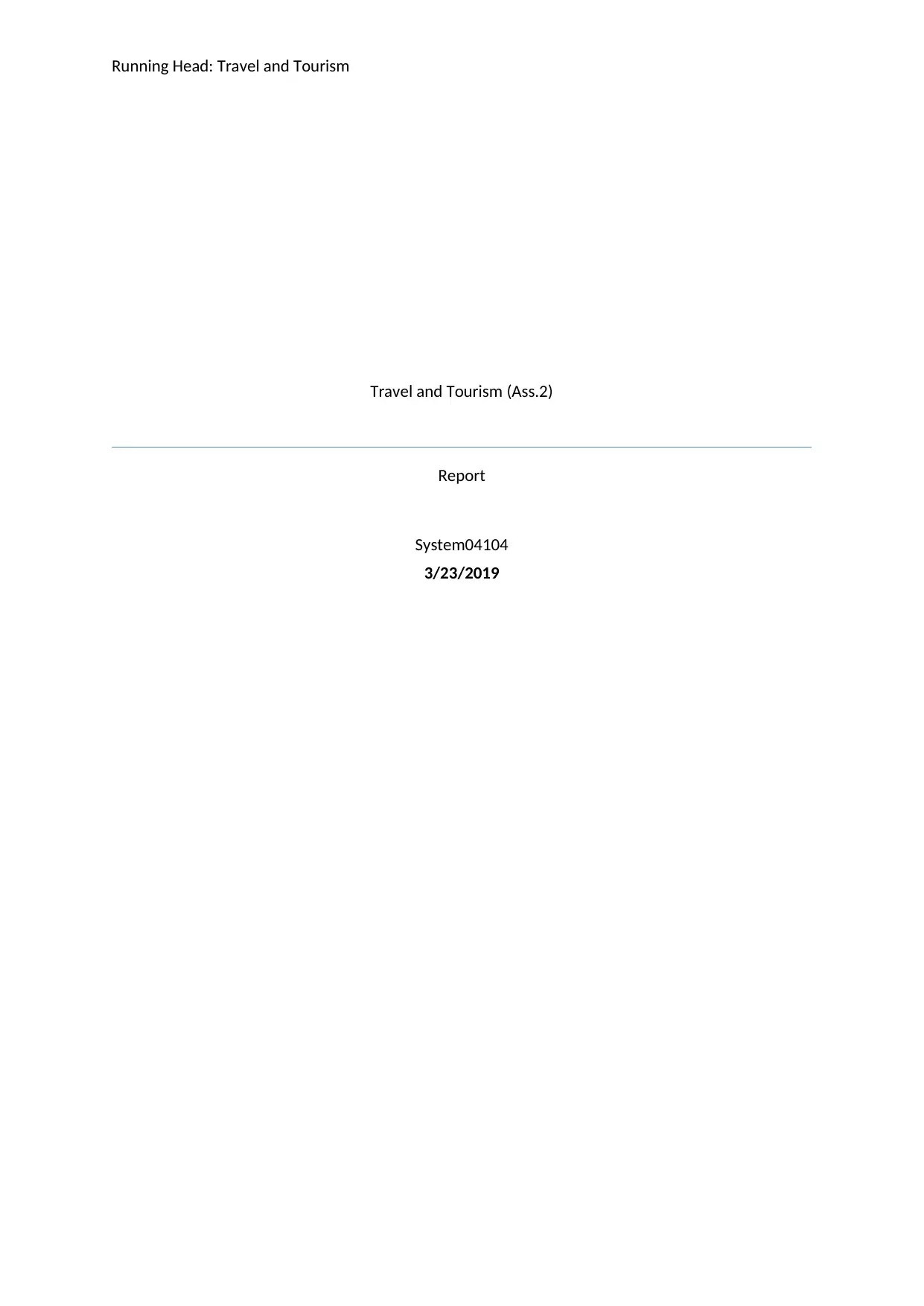
Running Head: Travel and Tourism
Travel and Tourism (Ass.2)
Report
System04104
3/23/2019
Travel and Tourism (Ass.2)
Report
System04104
3/23/2019
Paraphrase This Document
Need a fresh take? Get an instant paraphrase of this document with our AI Paraphraser
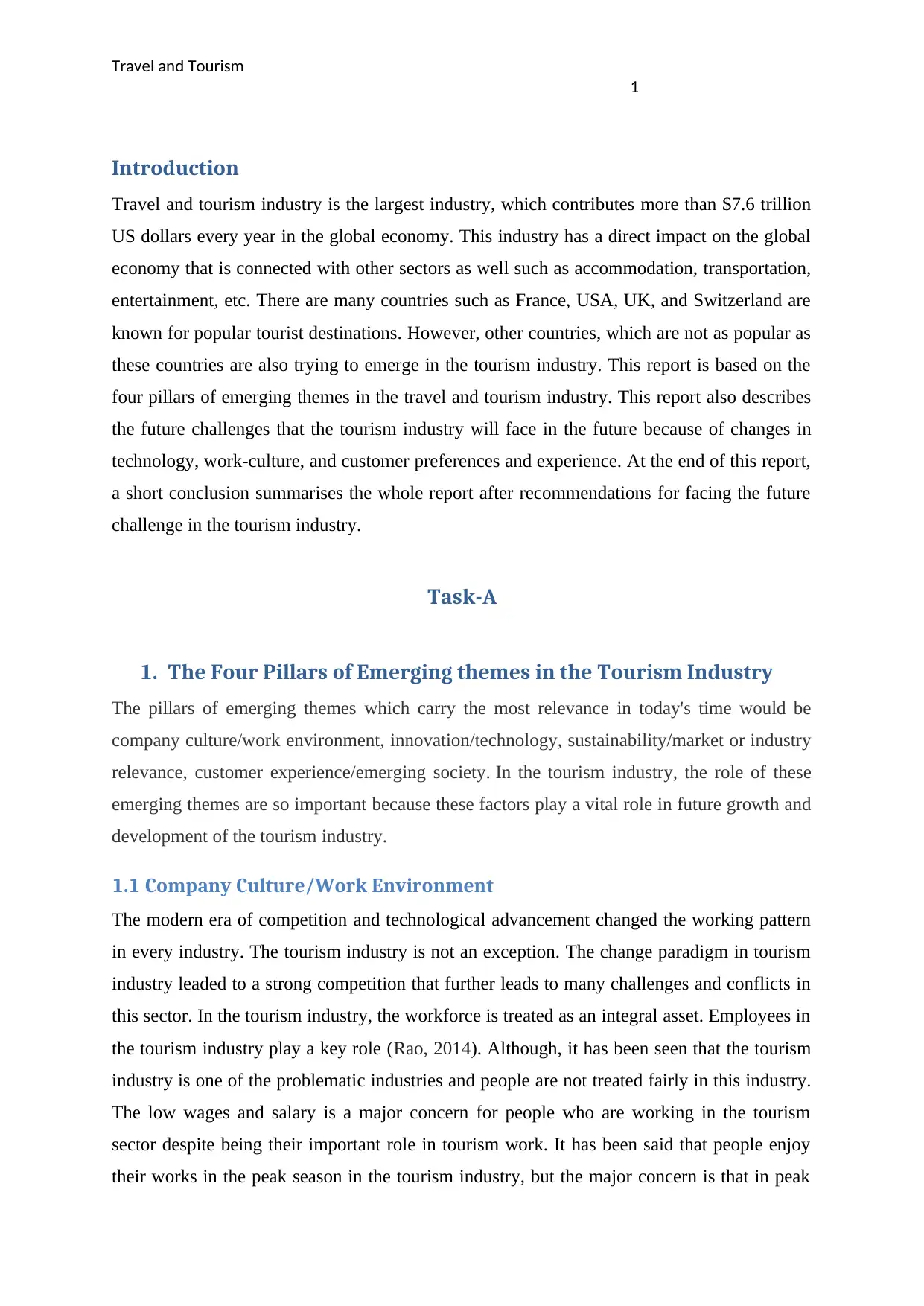
Travel and Tourism
1
Introduction
Travel and tourism industry is the largest industry, which contributes more than $7.6 trillion
US dollars every year in the global economy. This industry has a direct impact on the global
economy that is connected with other sectors as well such as accommodation, transportation,
entertainment, etc. There are many countries such as France, USA, UK, and Switzerland are
known for popular tourist destinations. However, other countries, which are not as popular as
these countries are also trying to emerge in the tourism industry. This report is based on the
four pillars of emerging themes in the travel and tourism industry. This report also describes
the future challenges that the tourism industry will face in the future because of changes in
technology, work-culture, and customer preferences and experience. At the end of this report,
a short conclusion summarises the whole report after recommendations for facing the future
challenge in the tourism industry.
Task-A
1. The Four Pillars of Emerging themes in the Tourism Industry
The pillars of emerging themes which carry the most relevance in today's time would be
company culture/work environment, innovation/technology, sustainability/market or industry
relevance, customer experience/emerging society. In the tourism industry, the role of these
emerging themes are so important because these factors play a vital role in future growth and
development of the tourism industry.
1.1 Company Culture/Work Environment
The modern era of competition and technological advancement changed the working pattern
in every industry. The tourism industry is not an exception. The change paradigm in tourism
industry leaded to a strong competition that further leads to many challenges and conflicts in
this sector. In the tourism industry, the workforce is treated as an integral asset. Employees in
the tourism industry play a key role (Rao, 2014). Although, it has been seen that the tourism
industry is one of the problematic industries and people are not treated fairly in this industry.
The low wages and salary is a major concern for people who are working in the tourism
sector despite being their important role in tourism work. It has been said that people enjoy
their works in the peak season in the tourism industry, but the major concern is that in peak
1
Introduction
Travel and tourism industry is the largest industry, which contributes more than $7.6 trillion
US dollars every year in the global economy. This industry has a direct impact on the global
economy that is connected with other sectors as well such as accommodation, transportation,
entertainment, etc. There are many countries such as France, USA, UK, and Switzerland are
known for popular tourist destinations. However, other countries, which are not as popular as
these countries are also trying to emerge in the tourism industry. This report is based on the
four pillars of emerging themes in the travel and tourism industry. This report also describes
the future challenges that the tourism industry will face in the future because of changes in
technology, work-culture, and customer preferences and experience. At the end of this report,
a short conclusion summarises the whole report after recommendations for facing the future
challenge in the tourism industry.
Task-A
1. The Four Pillars of Emerging themes in the Tourism Industry
The pillars of emerging themes which carry the most relevance in today's time would be
company culture/work environment, innovation/technology, sustainability/market or industry
relevance, customer experience/emerging society. In the tourism industry, the role of these
emerging themes are so important because these factors play a vital role in future growth and
development of the tourism industry.
1.1 Company Culture/Work Environment
The modern era of competition and technological advancement changed the working pattern
in every industry. The tourism industry is not an exception. The change paradigm in tourism
industry leaded to a strong competition that further leads to many challenges and conflicts in
this sector. In the tourism industry, the workforce is treated as an integral asset. Employees in
the tourism industry play a key role (Rao, 2014). Although, it has been seen that the tourism
industry is one of the problematic industries and people are not treated fairly in this industry.
The low wages and salary is a major concern for people who are working in the tourism
sector despite being their important role in tourism work. It has been said that people enjoy
their works in the peak season in the tourism industry, but the major concern is that in peak
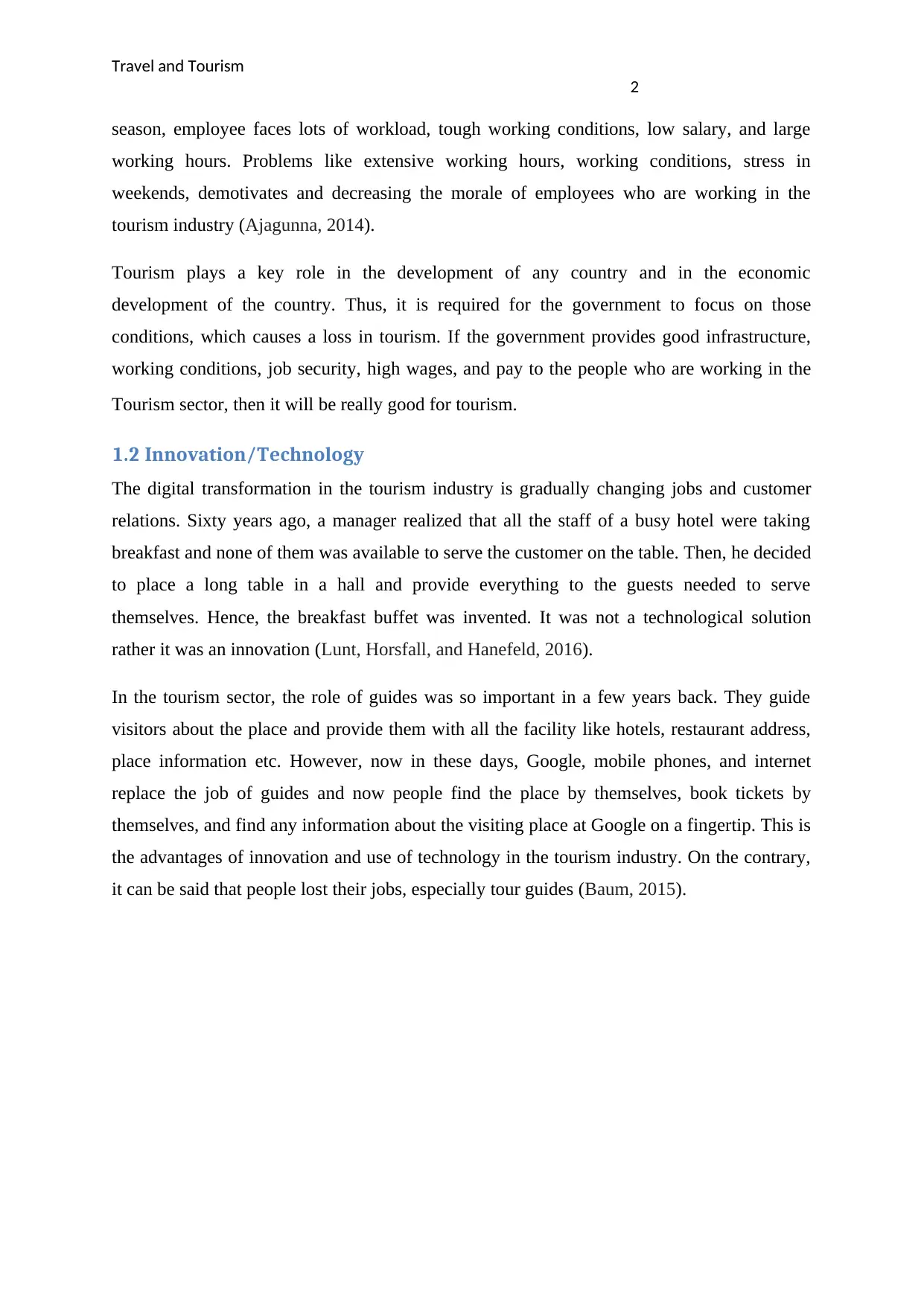
Travel and Tourism
2
season, employee faces lots of workload, tough working conditions, low salary, and large
working hours. Problems like extensive working hours, working conditions, stress in
weekends, demotivates and decreasing the morale of employees who are working in the
tourism industry (Ajagunna, 2014).
Tourism plays a key role in the development of any country and in the economic
development of the country. Thus, it is required for the government to focus on those
conditions, which causes a loss in tourism. If the government provides good infrastructure,
working conditions, job security, high wages, and pay to the people who are working in the
Tourism sector, then it will be really good for tourism.
1.2 Innovation/Technology
The digital transformation in the tourism industry is gradually changing jobs and customer
relations. Sixty years ago, a manager realized that all the staff of a busy hotel were taking
breakfast and none of them was available to serve the customer on the table. Then, he decided
to place a long table in a hall and provide everything to the guests needed to serve
themselves. Hence, the breakfast buffet was invented. It was not a technological solution
rather it was an innovation (Lunt, Horsfall, and Hanefeld, 2016).
In the tourism sector, the role of guides was so important in a few years back. They guide
visitors about the place and provide them with all the facility like hotels, restaurant address,
place information etc. However, now in these days, Google, mobile phones, and internet
replace the job of guides and now people find the place by themselves, book tickets by
themselves, and find any information about the visiting place at Google on a fingertip. This is
the advantages of innovation and use of technology in the tourism industry. On the contrary,
it can be said that people lost their jobs, especially tour guides (Baum, 2015).
2
season, employee faces lots of workload, tough working conditions, low salary, and large
working hours. Problems like extensive working hours, working conditions, stress in
weekends, demotivates and decreasing the morale of employees who are working in the
tourism industry (Ajagunna, 2014).
Tourism plays a key role in the development of any country and in the economic
development of the country. Thus, it is required for the government to focus on those
conditions, which causes a loss in tourism. If the government provides good infrastructure,
working conditions, job security, high wages, and pay to the people who are working in the
Tourism sector, then it will be really good for tourism.
1.2 Innovation/Technology
The digital transformation in the tourism industry is gradually changing jobs and customer
relations. Sixty years ago, a manager realized that all the staff of a busy hotel were taking
breakfast and none of them was available to serve the customer on the table. Then, he decided
to place a long table in a hall and provide everything to the guests needed to serve
themselves. Hence, the breakfast buffet was invented. It was not a technological solution
rather it was an innovation (Lunt, Horsfall, and Hanefeld, 2016).
In the tourism sector, the role of guides was so important in a few years back. They guide
visitors about the place and provide them with all the facility like hotels, restaurant address,
place information etc. However, now in these days, Google, mobile phones, and internet
replace the job of guides and now people find the place by themselves, book tickets by
themselves, and find any information about the visiting place at Google on a fingertip. This is
the advantages of innovation and use of technology in the tourism industry. On the contrary,
it can be said that people lost their jobs, especially tour guides (Baum, 2015).
⊘ This is a preview!⊘
Do you want full access?
Subscribe today to unlock all pages.

Trusted by 1+ million students worldwide
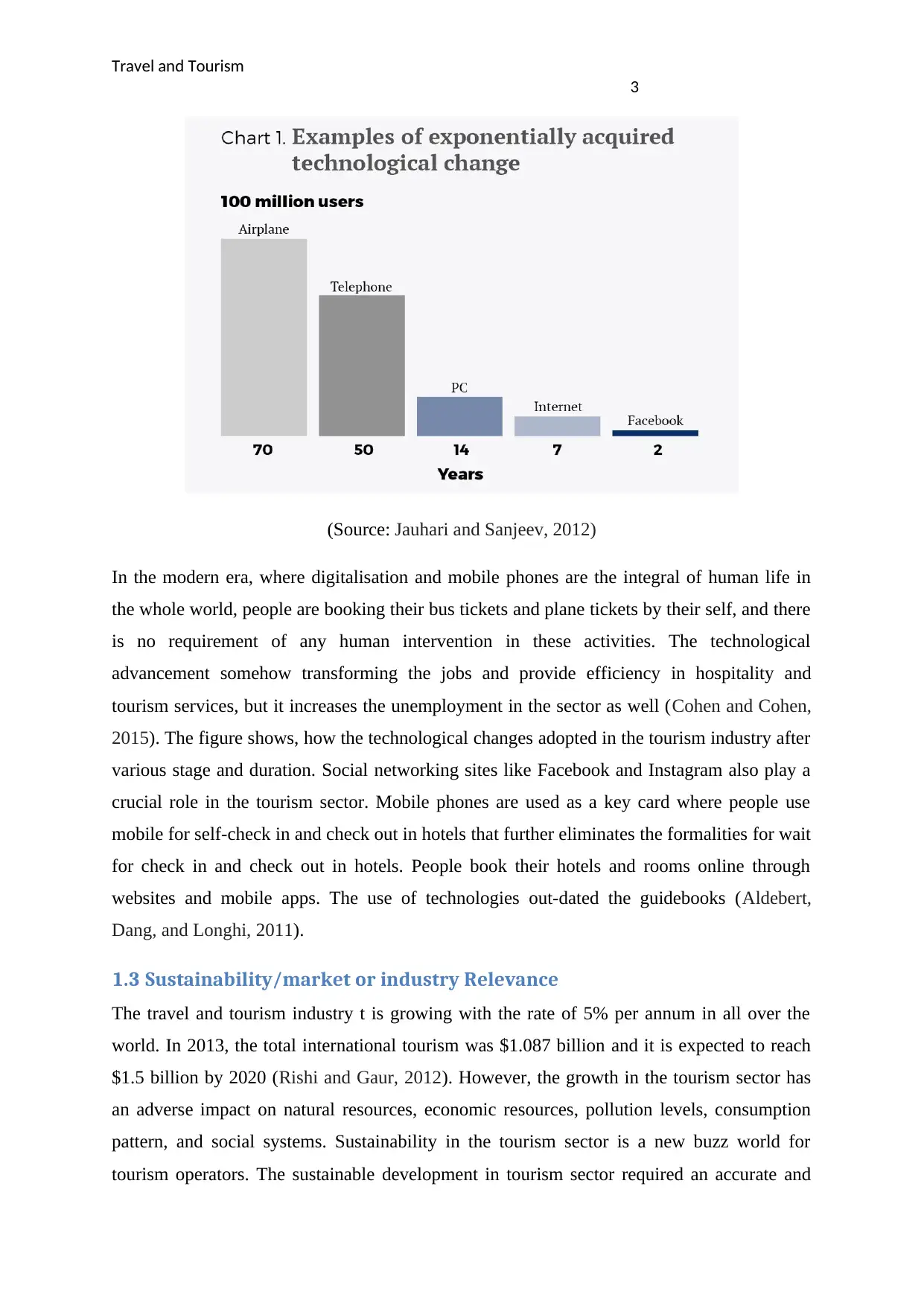
Travel and Tourism
3
(Source: Jauhari and Sanjeev, 2012)
In the modern era, where digitalisation and mobile phones are the integral of human life in
the whole world, people are booking their bus tickets and plane tickets by their self, and there
is no requirement of any human intervention in these activities. The technological
advancement somehow transforming the jobs and provide efficiency in hospitality and
tourism services, but it increases the unemployment in the sector as well (Cohen and Cohen,
2015). The figure shows, how the technological changes adopted in the tourism industry after
various stage and duration. Social networking sites like Facebook and Instagram also play a
crucial role in the tourism sector. Mobile phones are used as a key card where people use
mobile for self-check in and check out in hotels that further eliminates the formalities for wait
for check in and check out in hotels. People book their hotels and rooms online through
websites and mobile apps. The use of technologies out-dated the guidebooks (Aldebert,
Dang, and Longhi, 2011).
1.3 Sustainability/market or industry Relevance
The travel and tourism industry t is growing with the rate of 5% per annum in all over the
world. In 2013, the total international tourism was $1.087 billion and it is expected to reach
$1.5 billion by 2020 (Rishi and Gaur, 2012). However, the growth in the tourism sector has
an adverse impact on natural resources, economic resources, pollution levels, consumption
pattern, and social systems. Sustainability in the tourism sector is a new buzz world for
tourism operators. The sustainable development in tourism sector required an accurate and
3
(Source: Jauhari and Sanjeev, 2012)
In the modern era, where digitalisation and mobile phones are the integral of human life in
the whole world, people are booking their bus tickets and plane tickets by their self, and there
is no requirement of any human intervention in these activities. The technological
advancement somehow transforming the jobs and provide efficiency in hospitality and
tourism services, but it increases the unemployment in the sector as well (Cohen and Cohen,
2015). The figure shows, how the technological changes adopted in the tourism industry after
various stage and duration. Social networking sites like Facebook and Instagram also play a
crucial role in the tourism sector. Mobile phones are used as a key card where people use
mobile for self-check in and check out in hotels that further eliminates the formalities for wait
for check in and check out in hotels. People book their hotels and rooms online through
websites and mobile apps. The use of technologies out-dated the guidebooks (Aldebert,
Dang, and Longhi, 2011).
1.3 Sustainability/market or industry Relevance
The travel and tourism industry t is growing with the rate of 5% per annum in all over the
world. In 2013, the total international tourism was $1.087 billion and it is expected to reach
$1.5 billion by 2020 (Rishi and Gaur, 2012). However, the growth in the tourism sector has
an adverse impact on natural resources, economic resources, pollution levels, consumption
pattern, and social systems. Sustainability in the tourism sector is a new buzz world for
tourism operators. The sustainable development in tourism sector required an accurate and
Paraphrase This Document
Need a fresh take? Get an instant paraphrase of this document with our AI Paraphraser
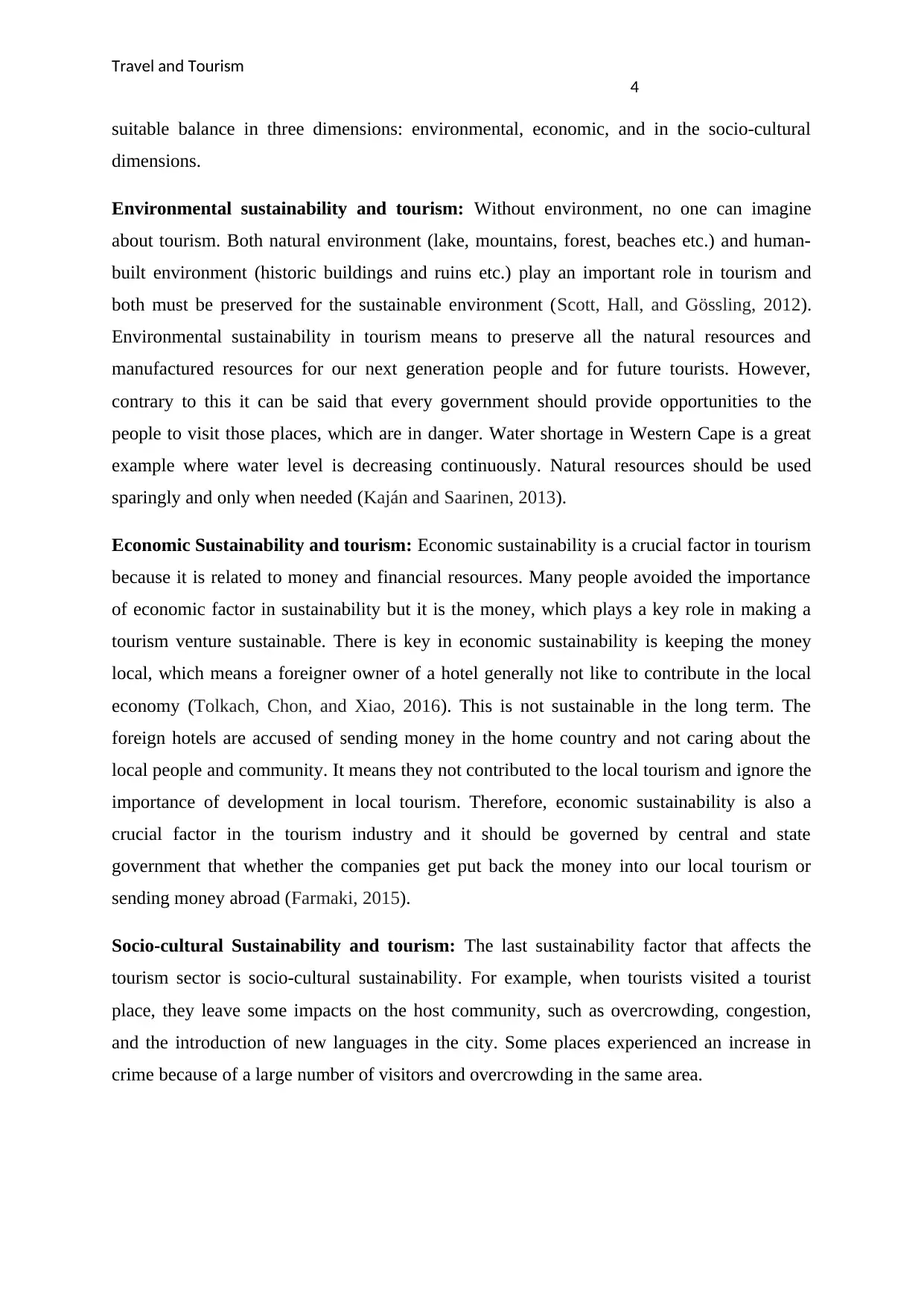
Travel and Tourism
4
suitable balance in three dimensions: environmental, economic, and in the socio-cultural
dimensions.
Environmental sustainability and tourism: Without environment, no one can imagine
about tourism. Both natural environment (lake, mountains, forest, beaches etc.) and human-
built environment (historic buildings and ruins etc.) play an important role in tourism and
both must be preserved for the sustainable environment (Scott, Hall, and Gössling, 2012).
Environmental sustainability in tourism means to preserve all the natural resources and
manufactured resources for our next generation people and for future tourists. However,
contrary to this it can be said that every government should provide opportunities to the
people to visit those places, which are in danger. Water shortage in Western Cape is a great
example where water level is decreasing continuously. Natural resources should be used
sparingly and only when needed (Kaján and Saarinen, 2013).
Economic Sustainability and tourism: Economic sustainability is a crucial factor in tourism
because it is related to money and financial resources. Many people avoided the importance
of economic factor in sustainability but it is the money, which plays a key role in making a
tourism venture sustainable. There is key in economic sustainability is keeping the money
local, which means a foreigner owner of a hotel generally not like to contribute in the local
economy (Tolkach, Chon, and Xiao, 2016). This is not sustainable in the long term. The
foreign hotels are accused of sending money in the home country and not caring about the
local people and community. It means they not contributed to the local tourism and ignore the
importance of development in local tourism. Therefore, economic sustainability is also a
crucial factor in the tourism industry and it should be governed by central and state
government that whether the companies get put back the money into our local tourism or
sending money abroad (Farmaki, 2015).
Socio-cultural Sustainability and tourism: The last sustainability factor that affects the
tourism sector is socio-cultural sustainability. For example, when tourists visited a tourist
place, they leave some impacts on the host community, such as overcrowding, congestion,
and the introduction of new languages in the city. Some places experienced an increase in
crime because of a large number of visitors and overcrowding in the same area.
4
suitable balance in three dimensions: environmental, economic, and in the socio-cultural
dimensions.
Environmental sustainability and tourism: Without environment, no one can imagine
about tourism. Both natural environment (lake, mountains, forest, beaches etc.) and human-
built environment (historic buildings and ruins etc.) play an important role in tourism and
both must be preserved for the sustainable environment (Scott, Hall, and Gössling, 2012).
Environmental sustainability in tourism means to preserve all the natural resources and
manufactured resources for our next generation people and for future tourists. However,
contrary to this it can be said that every government should provide opportunities to the
people to visit those places, which are in danger. Water shortage in Western Cape is a great
example where water level is decreasing continuously. Natural resources should be used
sparingly and only when needed (Kaján and Saarinen, 2013).
Economic Sustainability and tourism: Economic sustainability is a crucial factor in tourism
because it is related to money and financial resources. Many people avoided the importance
of economic factor in sustainability but it is the money, which plays a key role in making a
tourism venture sustainable. There is key in economic sustainability is keeping the money
local, which means a foreigner owner of a hotel generally not like to contribute in the local
economy (Tolkach, Chon, and Xiao, 2016). This is not sustainable in the long term. The
foreign hotels are accused of sending money in the home country and not caring about the
local people and community. It means they not contributed to the local tourism and ignore the
importance of development in local tourism. Therefore, economic sustainability is also a
crucial factor in the tourism industry and it should be governed by central and state
government that whether the companies get put back the money into our local tourism or
sending money abroad (Farmaki, 2015).
Socio-cultural Sustainability and tourism: The last sustainability factor that affects the
tourism sector is socio-cultural sustainability. For example, when tourists visited a tourist
place, they leave some impacts on the host community, such as overcrowding, congestion,
and the introduction of new languages in the city. Some places experienced an increase in
crime because of a large number of visitors and overcrowding in the same area.
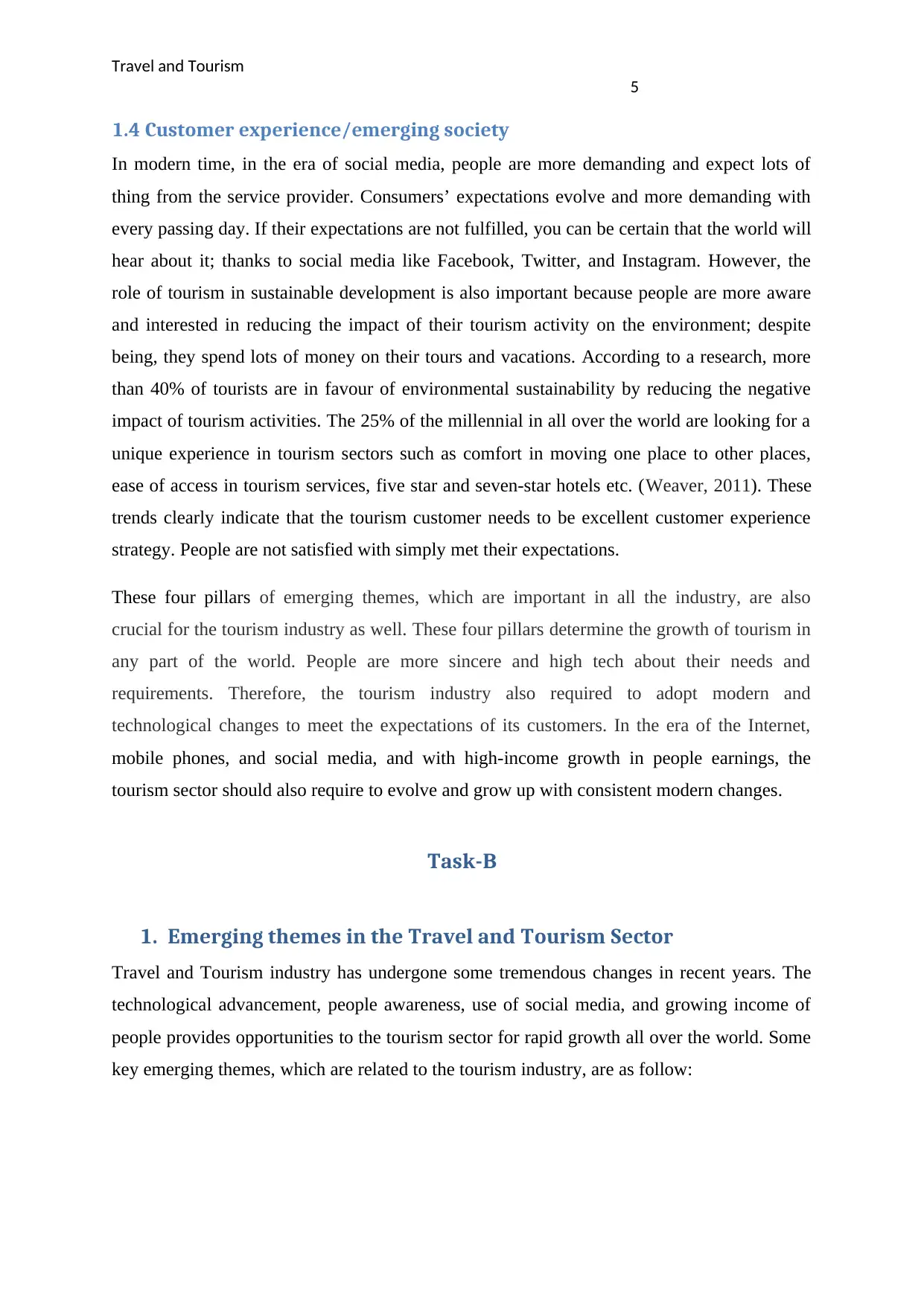
Travel and Tourism
5
1.4 Customer experience/emerging society
In modern time, in the era of social media, people are more demanding and expect lots of
thing from the service provider. Consumers’ expectations evolve and more demanding with
every passing day. If their expectations are not fulfilled, you can be certain that the world will
hear about it; thanks to social media like Facebook, Twitter, and Instagram. However, the
role of tourism in sustainable development is also important because people are more aware
and interested in reducing the impact of their tourism activity on the environment; despite
being, they spend lots of money on their tours and vacations. According to a research, more
than 40% of tourists are in favour of environmental sustainability by reducing the negative
impact of tourism activities. The 25% of the millennial in all over the world are looking for a
unique experience in tourism sectors such as comfort in moving one place to other places,
ease of access in tourism services, five star and seven-star hotels etc. (Weaver, 2011). These
trends clearly indicate that the tourism customer needs to be excellent customer experience
strategy. People are not satisfied with simply met their expectations.
These four pillars of emerging themes, which are important in all the industry, are also
crucial for the tourism industry as well. These four pillars determine the growth of tourism in
any part of the world. People are more sincere and high tech about their needs and
requirements. Therefore, the tourism industry also required to adopt modern and
technological changes to meet the expectations of its customers. In the era of the Internet,
mobile phones, and social media, and with high-income growth in people earnings, the
tourism sector should also require to evolve and grow up with consistent modern changes.
Task-B
1. Emerging themes in the Travel and Tourism Sector
Travel and Tourism industry has undergone some tremendous changes in recent years. The
technological advancement, people awareness, use of social media, and growing income of
people provides opportunities to the tourism sector for rapid growth all over the world. Some
key emerging themes, which are related to the tourism industry, are as follow:
5
1.4 Customer experience/emerging society
In modern time, in the era of social media, people are more demanding and expect lots of
thing from the service provider. Consumers’ expectations evolve and more demanding with
every passing day. If their expectations are not fulfilled, you can be certain that the world will
hear about it; thanks to social media like Facebook, Twitter, and Instagram. However, the
role of tourism in sustainable development is also important because people are more aware
and interested in reducing the impact of their tourism activity on the environment; despite
being, they spend lots of money on their tours and vacations. According to a research, more
than 40% of tourists are in favour of environmental sustainability by reducing the negative
impact of tourism activities. The 25% of the millennial in all over the world are looking for a
unique experience in tourism sectors such as comfort in moving one place to other places,
ease of access in tourism services, five star and seven-star hotels etc. (Weaver, 2011). These
trends clearly indicate that the tourism customer needs to be excellent customer experience
strategy. People are not satisfied with simply met their expectations.
These four pillars of emerging themes, which are important in all the industry, are also
crucial for the tourism industry as well. These four pillars determine the growth of tourism in
any part of the world. People are more sincere and high tech about their needs and
requirements. Therefore, the tourism industry also required to adopt modern and
technological changes to meet the expectations of its customers. In the era of the Internet,
mobile phones, and social media, and with high-income growth in people earnings, the
tourism sector should also require to evolve and grow up with consistent modern changes.
Task-B
1. Emerging themes in the Travel and Tourism Sector
Travel and Tourism industry has undergone some tremendous changes in recent years. The
technological advancement, people awareness, use of social media, and growing income of
people provides opportunities to the tourism sector for rapid growth all over the world. Some
key emerging themes, which are related to the tourism industry, are as follow:
⊘ This is a preview!⊘
Do you want full access?
Subscribe today to unlock all pages.

Trusted by 1+ million students worldwide
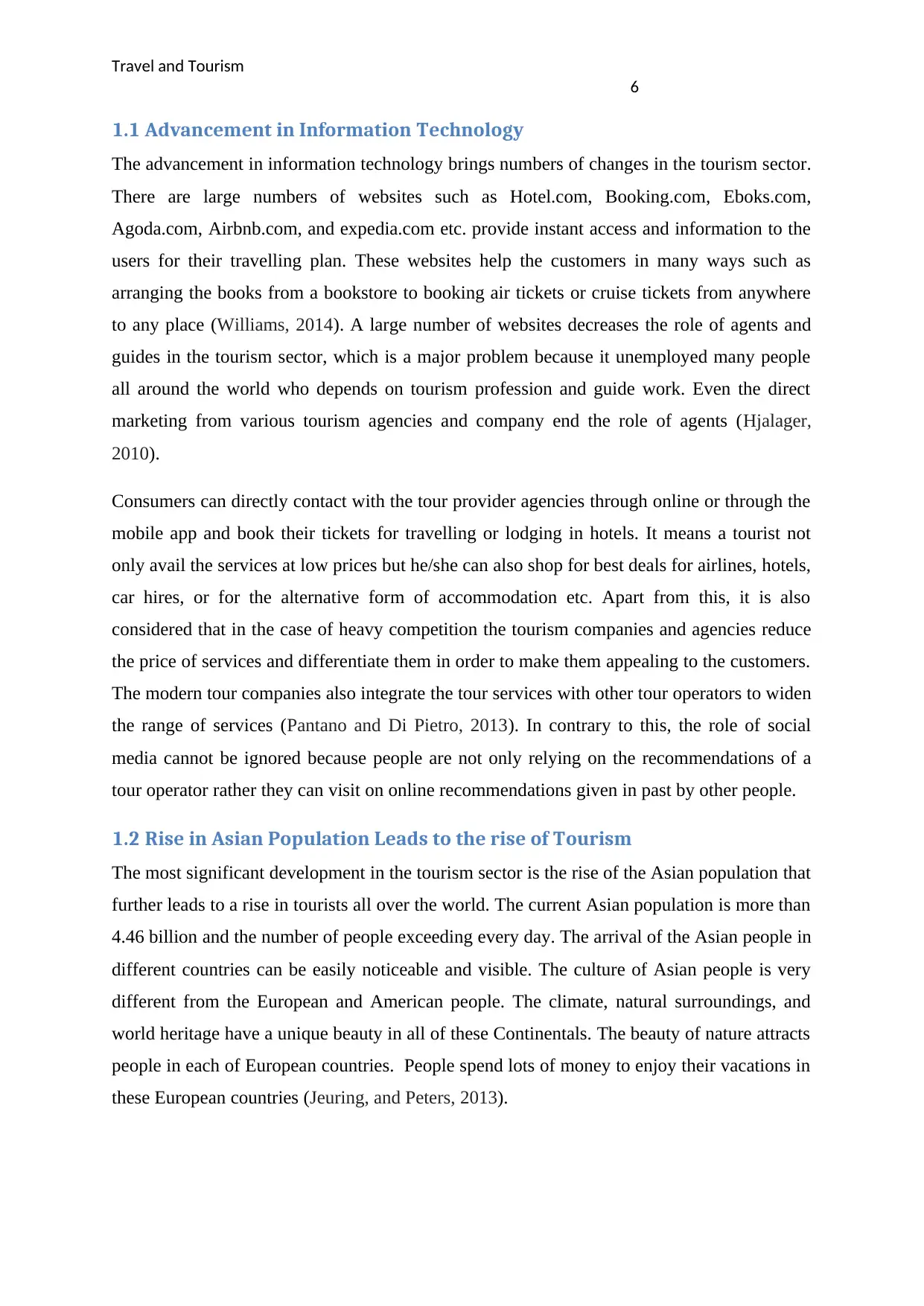
Travel and Tourism
6
1.1 Advancement in Information Technology
The advancement in information technology brings numbers of changes in the tourism sector.
There are large numbers of websites such as Hotel.com, Booking.com, Eboks.com,
Agoda.com, Airbnb.com, and expedia.com etc. provide instant access and information to the
users for their travelling plan. These websites help the customers in many ways such as
arranging the books from a bookstore to booking air tickets or cruise tickets from anywhere
to any place (Williams, 2014). A large number of websites decreases the role of agents and
guides in the tourism sector, which is a major problem because it unemployed many people
all around the world who depends on tourism profession and guide work. Even the direct
marketing from various tourism agencies and company end the role of agents (Hjalager,
2010).
Consumers can directly contact with the tour provider agencies through online or through the
mobile app and book their tickets for travelling or lodging in hotels. It means a tourist not
only avail the services at low prices but he/she can also shop for best deals for airlines, hotels,
car hires, or for the alternative form of accommodation etc. Apart from this, it is also
considered that in the case of heavy competition the tourism companies and agencies reduce
the price of services and differentiate them in order to make them appealing to the customers.
The modern tour companies also integrate the tour services with other tour operators to widen
the range of services (Pantano and Di Pietro, 2013). In contrary to this, the role of social
media cannot be ignored because people are not only relying on the recommendations of a
tour operator rather they can visit on online recommendations given in past by other people.
1.2 Rise in Asian Population Leads to the rise of Tourism
The most significant development in the tourism sector is the rise of the Asian population that
further leads to a rise in tourists all over the world. The current Asian population is more than
4.46 billion and the number of people exceeding every day. The arrival of the Asian people in
different countries can be easily noticeable and visible. The culture of Asian people is very
different from the European and American people. The climate, natural surroundings, and
world heritage have a unique beauty in all of these Continentals. The beauty of nature attracts
people in each of European countries. People spend lots of money to enjoy their vacations in
these European countries (Jeuring, and Peters, 2013).
6
1.1 Advancement in Information Technology
The advancement in information technology brings numbers of changes in the tourism sector.
There are large numbers of websites such as Hotel.com, Booking.com, Eboks.com,
Agoda.com, Airbnb.com, and expedia.com etc. provide instant access and information to the
users for their travelling plan. These websites help the customers in many ways such as
arranging the books from a bookstore to booking air tickets or cruise tickets from anywhere
to any place (Williams, 2014). A large number of websites decreases the role of agents and
guides in the tourism sector, which is a major problem because it unemployed many people
all around the world who depends on tourism profession and guide work. Even the direct
marketing from various tourism agencies and company end the role of agents (Hjalager,
2010).
Consumers can directly contact with the tour provider agencies through online or through the
mobile app and book their tickets for travelling or lodging in hotels. It means a tourist not
only avail the services at low prices but he/she can also shop for best deals for airlines, hotels,
car hires, or for the alternative form of accommodation etc. Apart from this, it is also
considered that in the case of heavy competition the tourism companies and agencies reduce
the price of services and differentiate them in order to make them appealing to the customers.
The modern tour companies also integrate the tour services with other tour operators to widen
the range of services (Pantano and Di Pietro, 2013). In contrary to this, the role of social
media cannot be ignored because people are not only relying on the recommendations of a
tour operator rather they can visit on online recommendations given in past by other people.
1.2 Rise in Asian Population Leads to the rise of Tourism
The most significant development in the tourism sector is the rise of the Asian population that
further leads to a rise in tourists all over the world. The current Asian population is more than
4.46 billion and the number of people exceeding every day. The arrival of the Asian people in
different countries can be easily noticeable and visible. The culture of Asian people is very
different from the European and American people. The climate, natural surroundings, and
world heritage have a unique beauty in all of these Continentals. The beauty of nature attracts
people in each of European countries. People spend lots of money to enjoy their vacations in
these European countries (Jeuring, and Peters, 2013).
Paraphrase This Document
Need a fresh take? Get an instant paraphrase of this document with our AI Paraphraser
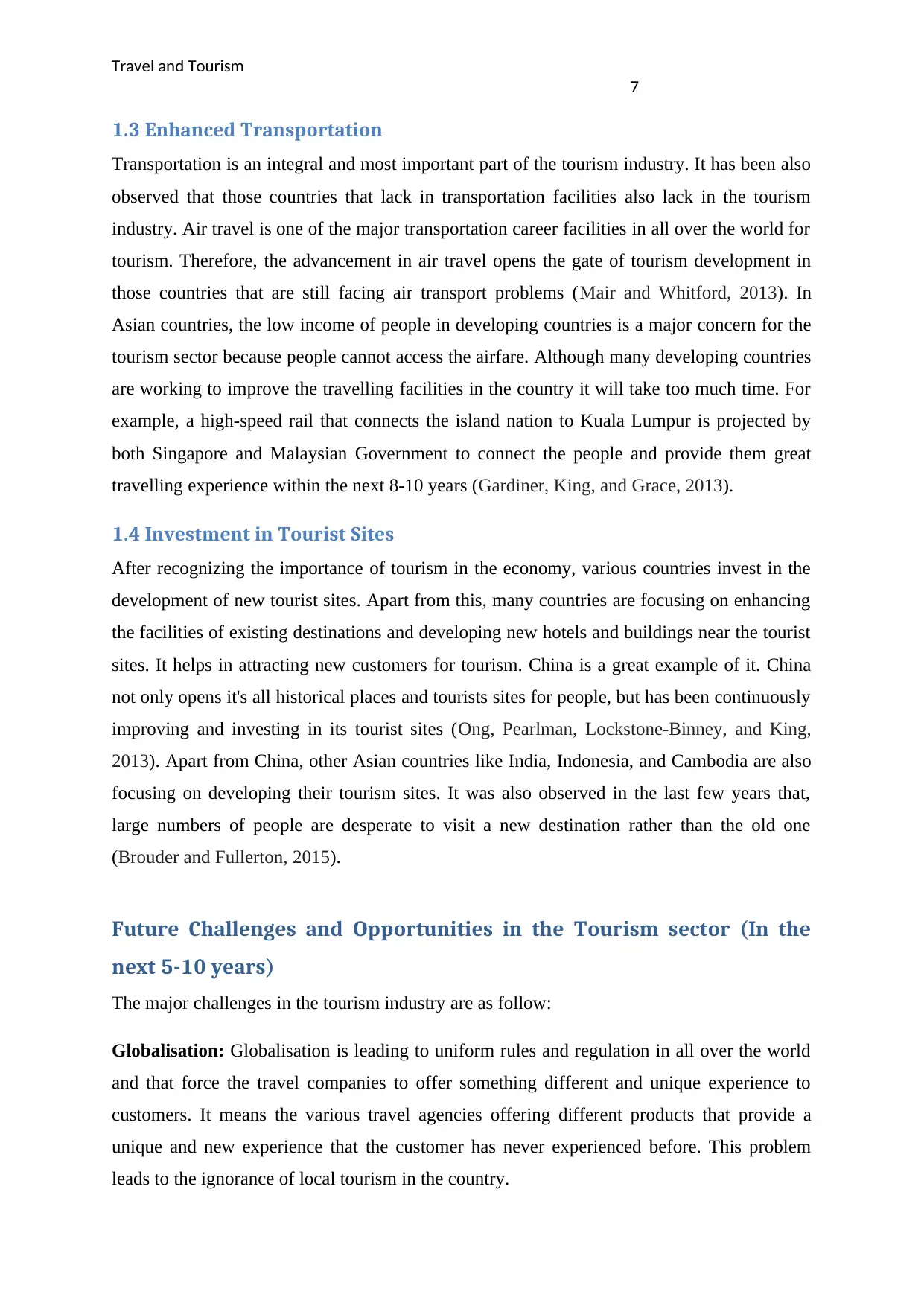
Travel and Tourism
7
1.3 Enhanced Transportation
Transportation is an integral and most important part of the tourism industry. It has been also
observed that those countries that lack in transportation facilities also lack in the tourism
industry. Air travel is one of the major transportation career facilities in all over the world for
tourism. Therefore, the advancement in air travel opens the gate of tourism development in
those countries that are still facing air transport problems (Mair and Whitford, 2013). In
Asian countries, the low income of people in developing countries is a major concern for the
tourism sector because people cannot access the airfare. Although many developing countries
are working to improve the travelling facilities in the country it will take too much time. For
example, a high-speed rail that connects the island nation to Kuala Lumpur is projected by
both Singapore and Malaysian Government to connect the people and provide them great
travelling experience within the next 8-10 years (Gardiner, King, and Grace, 2013).
1.4 Investment in Tourist Sites
After recognizing the importance of tourism in the economy, various countries invest in the
development of new tourist sites. Apart from this, many countries are focusing on enhancing
the facilities of existing destinations and developing new hotels and buildings near the tourist
sites. It helps in attracting new customers for tourism. China is a great example of it. China
not only opens it's all historical places and tourists sites for people, but has been continuously
improving and investing in its tourist sites (Ong, Pearlman, Lockstone-Binney, and King,
2013). Apart from China, other Asian countries like India, Indonesia, and Cambodia are also
focusing on developing their tourism sites. It was also observed in the last few years that,
large numbers of people are desperate to visit a new destination rather than the old one
(Brouder and Fullerton, 2015).
Future Challenges and Opportunities in the Tourism sector (In the
next 5-10 years)
The major challenges in the tourism industry are as follow:
Globalisation: Globalisation is leading to uniform rules and regulation in all over the world
and that force the travel companies to offer something different and unique experience to
customers. It means the various travel agencies offering different products that provide a
unique and new experience that the customer has never experienced before. This problem
leads to the ignorance of local tourism in the country.
7
1.3 Enhanced Transportation
Transportation is an integral and most important part of the tourism industry. It has been also
observed that those countries that lack in transportation facilities also lack in the tourism
industry. Air travel is one of the major transportation career facilities in all over the world for
tourism. Therefore, the advancement in air travel opens the gate of tourism development in
those countries that are still facing air transport problems (Mair and Whitford, 2013). In
Asian countries, the low income of people in developing countries is a major concern for the
tourism sector because people cannot access the airfare. Although many developing countries
are working to improve the travelling facilities in the country it will take too much time. For
example, a high-speed rail that connects the island nation to Kuala Lumpur is projected by
both Singapore and Malaysian Government to connect the people and provide them great
travelling experience within the next 8-10 years (Gardiner, King, and Grace, 2013).
1.4 Investment in Tourist Sites
After recognizing the importance of tourism in the economy, various countries invest in the
development of new tourist sites. Apart from this, many countries are focusing on enhancing
the facilities of existing destinations and developing new hotels and buildings near the tourist
sites. It helps in attracting new customers for tourism. China is a great example of it. China
not only opens it's all historical places and tourists sites for people, but has been continuously
improving and investing in its tourist sites (Ong, Pearlman, Lockstone-Binney, and King,
2013). Apart from China, other Asian countries like India, Indonesia, and Cambodia are also
focusing on developing their tourism sites. It was also observed in the last few years that,
large numbers of people are desperate to visit a new destination rather than the old one
(Brouder and Fullerton, 2015).
Future Challenges and Opportunities in the Tourism sector (In the
next 5-10 years)
The major challenges in the tourism industry are as follow:
Globalisation: Globalisation is leading to uniform rules and regulation in all over the world
and that force the travel companies to offer something different and unique experience to
customers. It means the various travel agencies offering different products that provide a
unique and new experience that the customer has never experienced before. This problem
leads to the ignorance of local tourism in the country.
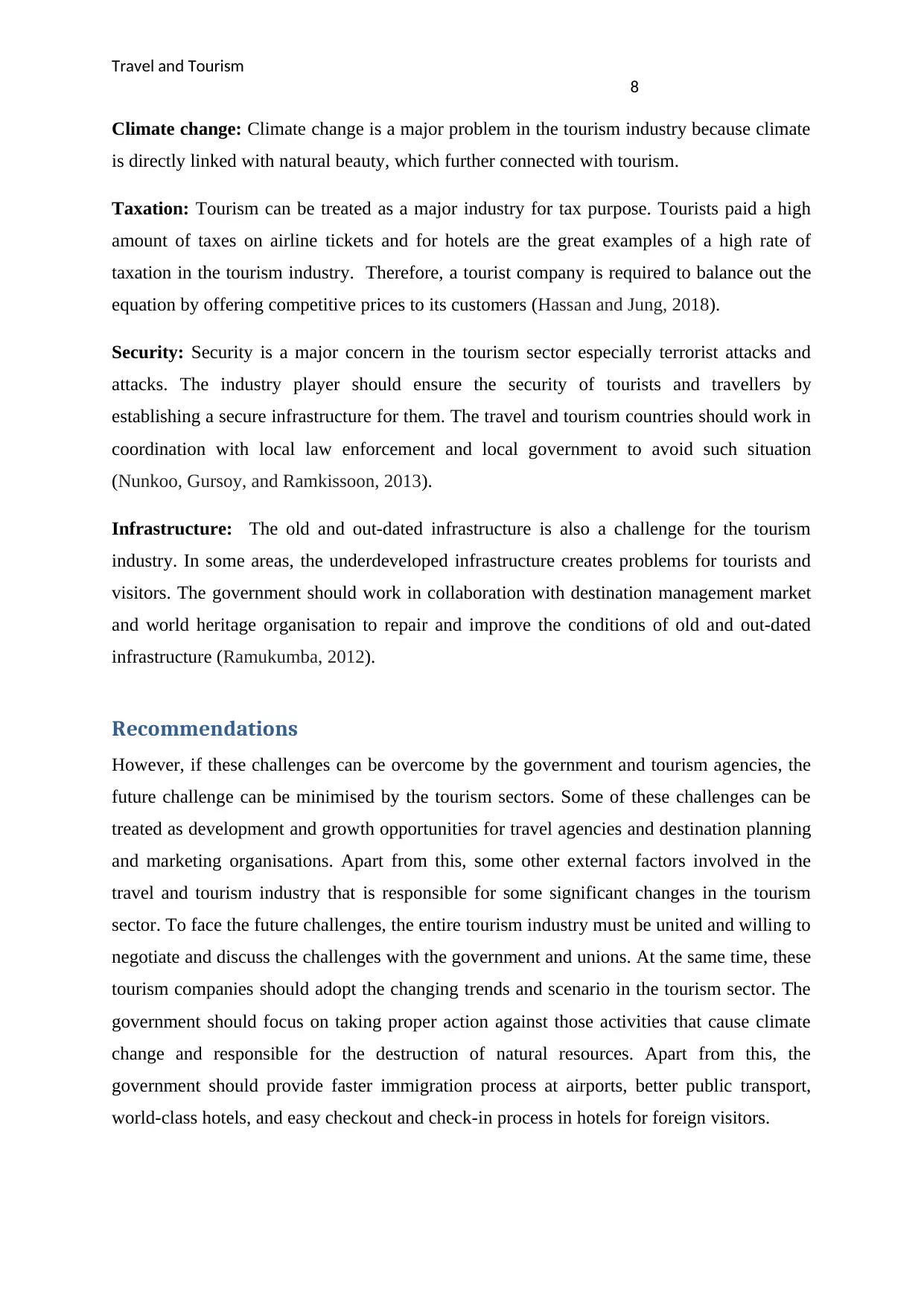
Travel and Tourism
8
Climate change: Climate change is a major problem in the tourism industry because climate
is directly linked with natural beauty, which further connected with tourism.
Taxation: Tourism can be treated as a major industry for tax purpose. Tourists paid a high
amount of taxes on airline tickets and for hotels are the great examples of a high rate of
taxation in the tourism industry. Therefore, a tourist company is required to balance out the
equation by offering competitive prices to its customers (Hassan and Jung, 2018).
Security: Security is a major concern in the tourism sector especially terrorist attacks and
attacks. The industry player should ensure the security of tourists and travellers by
establishing a secure infrastructure for them. The travel and tourism countries should work in
coordination with local law enforcement and local government to avoid such situation
(Nunkoo, Gursoy, and Ramkissoon, 2013).
Infrastructure: The old and out-dated infrastructure is also a challenge for the tourism
industry. In some areas, the underdeveloped infrastructure creates problems for tourists and
visitors. The government should work in collaboration with destination management market
and world heritage organisation to repair and improve the conditions of old and out-dated
infrastructure (Ramukumba, 2012).
Recommendations
However, if these challenges can be overcome by the government and tourism agencies, the
future challenge can be minimised by the tourism sectors. Some of these challenges can be
treated as development and growth opportunities for travel agencies and destination planning
and marketing organisations. Apart from this, some other external factors involved in the
travel and tourism industry that is responsible for some significant changes in the tourism
sector. To face the future challenges, the entire tourism industry must be united and willing to
negotiate and discuss the challenges with the government and unions. At the same time, these
tourism companies should adopt the changing trends and scenario in the tourism sector. The
government should focus on taking proper action against those activities that cause climate
change and responsible for the destruction of natural resources. Apart from this, the
government should provide faster immigration process at airports, better public transport,
world-class hotels, and easy checkout and check-in process in hotels for foreign visitors.
8
Climate change: Climate change is a major problem in the tourism industry because climate
is directly linked with natural beauty, which further connected with tourism.
Taxation: Tourism can be treated as a major industry for tax purpose. Tourists paid a high
amount of taxes on airline tickets and for hotels are the great examples of a high rate of
taxation in the tourism industry. Therefore, a tourist company is required to balance out the
equation by offering competitive prices to its customers (Hassan and Jung, 2018).
Security: Security is a major concern in the tourism sector especially terrorist attacks and
attacks. The industry player should ensure the security of tourists and travellers by
establishing a secure infrastructure for them. The travel and tourism countries should work in
coordination with local law enforcement and local government to avoid such situation
(Nunkoo, Gursoy, and Ramkissoon, 2013).
Infrastructure: The old and out-dated infrastructure is also a challenge for the tourism
industry. In some areas, the underdeveloped infrastructure creates problems for tourists and
visitors. The government should work in collaboration with destination management market
and world heritage organisation to repair and improve the conditions of old and out-dated
infrastructure (Ramukumba, 2012).
Recommendations
However, if these challenges can be overcome by the government and tourism agencies, the
future challenge can be minimised by the tourism sectors. Some of these challenges can be
treated as development and growth opportunities for travel agencies and destination planning
and marketing organisations. Apart from this, some other external factors involved in the
travel and tourism industry that is responsible for some significant changes in the tourism
sector. To face the future challenges, the entire tourism industry must be united and willing to
negotiate and discuss the challenges with the government and unions. At the same time, these
tourism companies should adopt the changing trends and scenario in the tourism sector. The
government should focus on taking proper action against those activities that cause climate
change and responsible for the destruction of natural resources. Apart from this, the
government should provide faster immigration process at airports, better public transport,
world-class hotels, and easy checkout and check-in process in hotels for foreign visitors.
⊘ This is a preview!⊘
Do you want full access?
Subscribe today to unlock all pages.

Trusted by 1+ million students worldwide
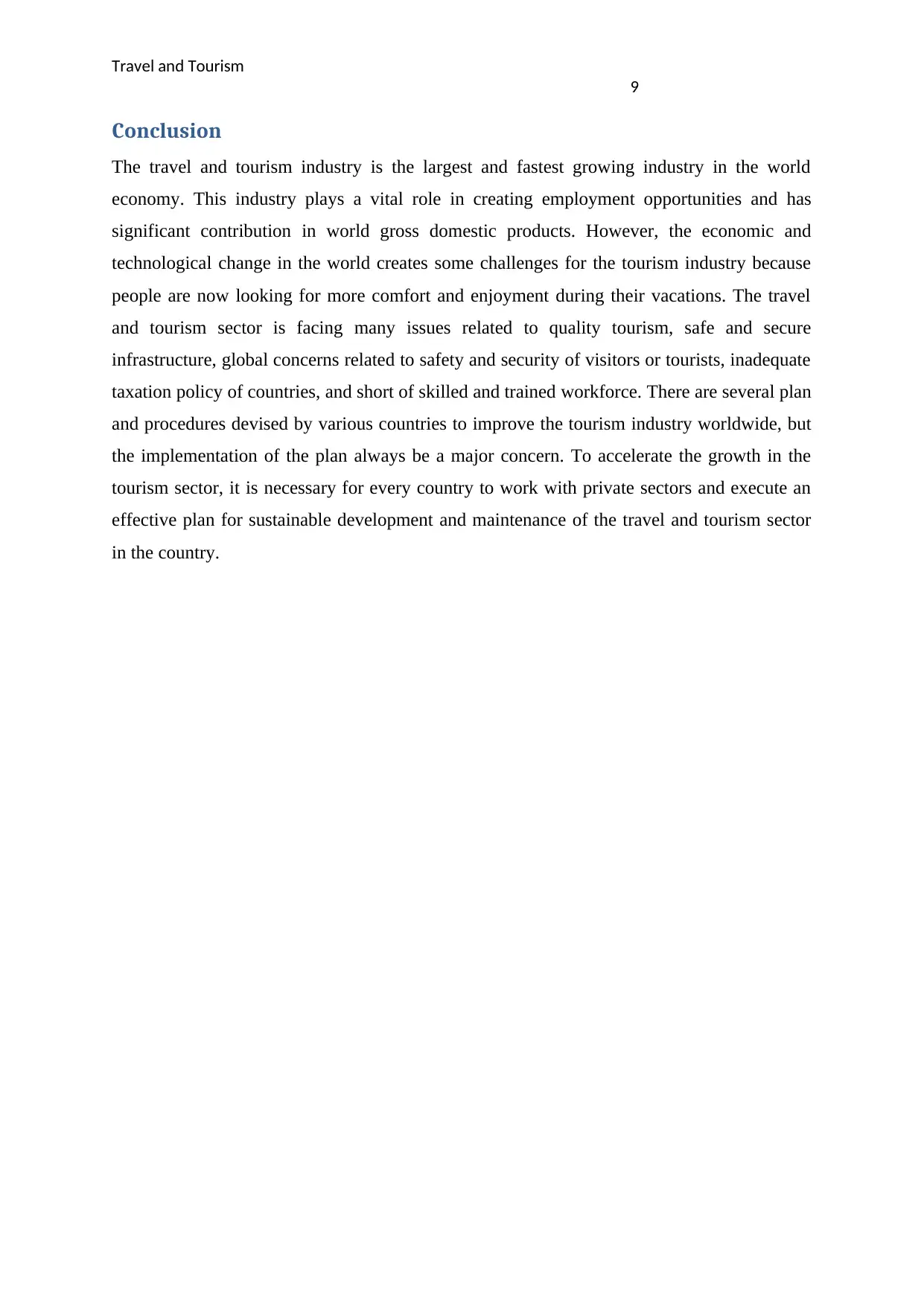
Travel and Tourism
9
Conclusion
The travel and tourism industry is the largest and fastest growing industry in the world
economy. This industry plays a vital role in creating employment opportunities and has
significant contribution in world gross domestic products. However, the economic and
technological change in the world creates some challenges for the tourism industry because
people are now looking for more comfort and enjoyment during their vacations. The travel
and tourism sector is facing many issues related to quality tourism, safe and secure
infrastructure, global concerns related to safety and security of visitors or tourists, inadequate
taxation policy of countries, and short of skilled and trained workforce. There are several plan
and procedures devised by various countries to improve the tourism industry worldwide, but
the implementation of the plan always be a major concern. To accelerate the growth in the
tourism sector, it is necessary for every country to work with private sectors and execute an
effective plan for sustainable development and maintenance of the travel and tourism sector
in the country.
9
Conclusion
The travel and tourism industry is the largest and fastest growing industry in the world
economy. This industry plays a vital role in creating employment opportunities and has
significant contribution in world gross domestic products. However, the economic and
technological change in the world creates some challenges for the tourism industry because
people are now looking for more comfort and enjoyment during their vacations. The travel
and tourism sector is facing many issues related to quality tourism, safe and secure
infrastructure, global concerns related to safety and security of visitors or tourists, inadequate
taxation policy of countries, and short of skilled and trained workforce. There are several plan
and procedures devised by various countries to improve the tourism industry worldwide, but
the implementation of the plan always be a major concern. To accelerate the growth in the
tourism sector, it is necessary for every country to work with private sectors and execute an
effective plan for sustainable development and maintenance of the travel and tourism sector
in the country.
Paraphrase This Document
Need a fresh take? Get an instant paraphrase of this document with our AI Paraphraser
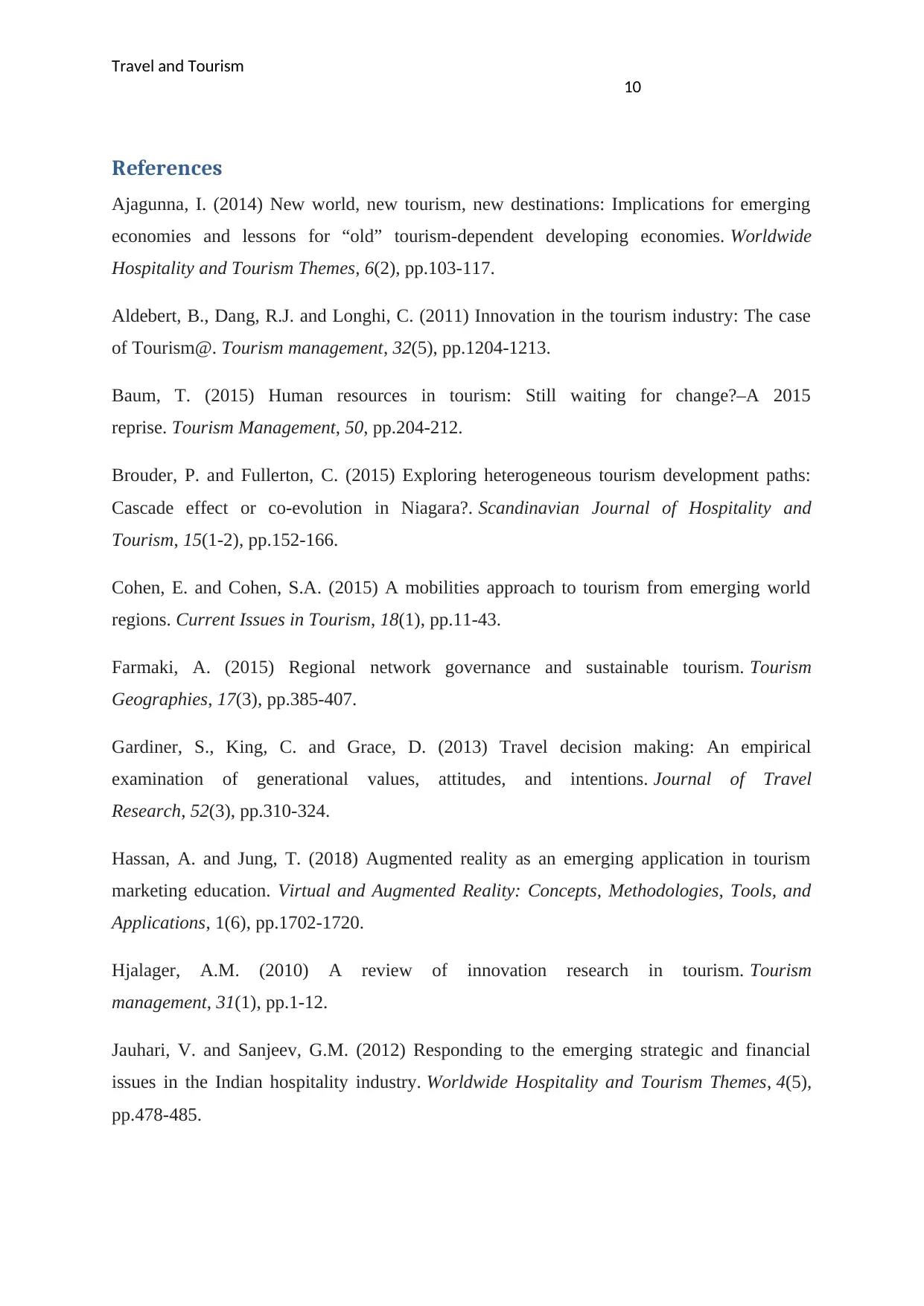
Travel and Tourism
10
References
Ajagunna, I. (2014) New world, new tourism, new destinations: Implications for emerging
economies and lessons for “old” tourism-dependent developing economies. Worldwide
Hospitality and Tourism Themes, 6(2), pp.103-117.
Aldebert, B., Dang, R.J. and Longhi, C. (2011) Innovation in the tourism industry: The case
of Tourism@. Tourism management, 32(5), pp.1204-1213.
Baum, T. (2015) Human resources in tourism: Still waiting for change?–A 2015
reprise. Tourism Management, 50, pp.204-212.
Brouder, P. and Fullerton, C. (2015) Exploring heterogeneous tourism development paths:
Cascade effect or co-evolution in Niagara?. Scandinavian Journal of Hospitality and
Tourism, 15(1-2), pp.152-166.
Cohen, E. and Cohen, S.A. (2015) A mobilities approach to tourism from emerging world
regions. Current Issues in Tourism, 18(1), pp.11-43.
Farmaki, A. (2015) Regional network governance and sustainable tourism. Tourism
Geographies, 17(3), pp.385-407.
Gardiner, S., King, C. and Grace, D. (2013) Travel decision making: An empirical
examination of generational values, attitudes, and intentions. Journal of Travel
Research, 52(3), pp.310-324.
Hassan, A. and Jung, T. (2018) Augmented reality as an emerging application in tourism
marketing education. Virtual and Augmented Reality: Concepts, Methodologies, Tools, and
Applications, 1(6), pp.1702-1720.
Hjalager, A.M. (2010) A review of innovation research in tourism. Tourism
management, 31(1), pp.1-12.
Jauhari, V. and Sanjeev, G.M. (2012) Responding to the emerging strategic and financial
issues in the Indian hospitality industry. Worldwide Hospitality and Tourism Themes, 4(5),
pp.478-485.
10
References
Ajagunna, I. (2014) New world, new tourism, new destinations: Implications for emerging
economies and lessons for “old” tourism-dependent developing economies. Worldwide
Hospitality and Tourism Themes, 6(2), pp.103-117.
Aldebert, B., Dang, R.J. and Longhi, C. (2011) Innovation in the tourism industry: The case
of Tourism@. Tourism management, 32(5), pp.1204-1213.
Baum, T. (2015) Human resources in tourism: Still waiting for change?–A 2015
reprise. Tourism Management, 50, pp.204-212.
Brouder, P. and Fullerton, C. (2015) Exploring heterogeneous tourism development paths:
Cascade effect or co-evolution in Niagara?. Scandinavian Journal of Hospitality and
Tourism, 15(1-2), pp.152-166.
Cohen, E. and Cohen, S.A. (2015) A mobilities approach to tourism from emerging world
regions. Current Issues in Tourism, 18(1), pp.11-43.
Farmaki, A. (2015) Regional network governance and sustainable tourism. Tourism
Geographies, 17(3), pp.385-407.
Gardiner, S., King, C. and Grace, D. (2013) Travel decision making: An empirical
examination of generational values, attitudes, and intentions. Journal of Travel
Research, 52(3), pp.310-324.
Hassan, A. and Jung, T. (2018) Augmented reality as an emerging application in tourism
marketing education. Virtual and Augmented Reality: Concepts, Methodologies, Tools, and
Applications, 1(6), pp.1702-1720.
Hjalager, A.M. (2010) A review of innovation research in tourism. Tourism
management, 31(1), pp.1-12.
Jauhari, V. and Sanjeev, G.M. (2012) Responding to the emerging strategic and financial
issues in the Indian hospitality industry. Worldwide Hospitality and Tourism Themes, 4(5),
pp.478-485.
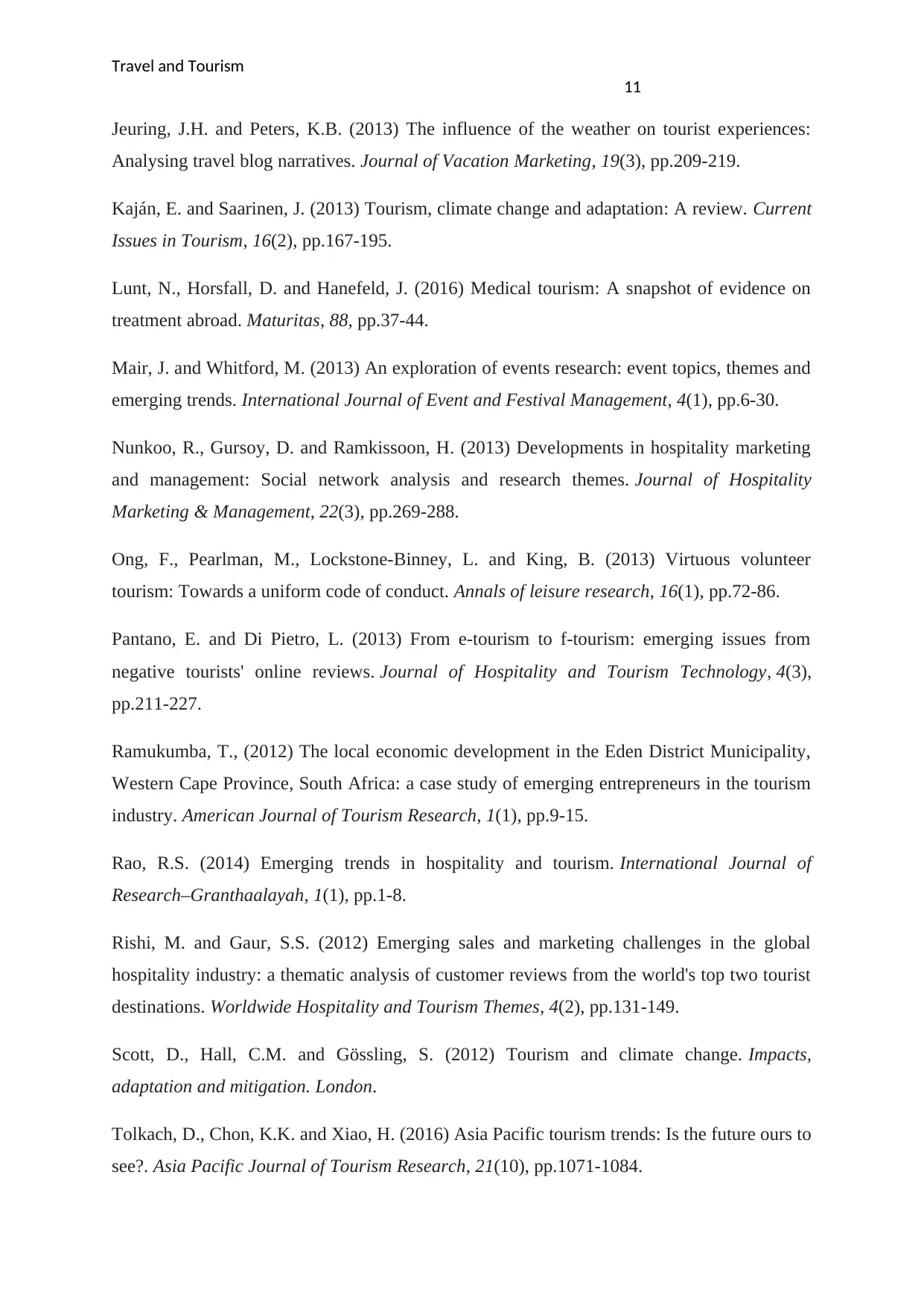
Travel and Tourism
11
Jeuring, J.H. and Peters, K.B. (2013) The influence of the weather on tourist experiences:
Analysing travel blog narratives. Journal of Vacation Marketing, 19(3), pp.209-219.
Kaján, E. and Saarinen, J. (2013) Tourism, climate change and adaptation: A review. Current
Issues in Tourism, 16(2), pp.167-195.
Lunt, N., Horsfall, D. and Hanefeld, J. (2016) Medical tourism: A snapshot of evidence on
treatment abroad. Maturitas, 88, pp.37-44.
Mair, J. and Whitford, M. (2013) An exploration of events research: event topics, themes and
emerging trends. International Journal of Event and Festival Management, 4(1), pp.6-30.
Nunkoo, R., Gursoy, D. and Ramkissoon, H. (2013) Developments in hospitality marketing
and management: Social network analysis and research themes. Journal of Hospitality
Marketing & Management, 22(3), pp.269-288.
Ong, F., Pearlman, M., Lockstone-Binney, L. and King, B. (2013) Virtuous volunteer
tourism: Towards a uniform code of conduct. Annals of leisure research, 16(1), pp.72-86.
Pantano, E. and Di Pietro, L. (2013) From e-tourism to f-tourism: emerging issues from
negative tourists' online reviews. Journal of Hospitality and Tourism Technology, 4(3),
pp.211-227.
Ramukumba, T., (2012) The local economic development in the Eden District Municipality,
Western Cape Province, South Africa: a case study of emerging entrepreneurs in the tourism
industry. American Journal of Tourism Research, 1(1), pp.9-15.
Rao, R.S. (2014) Emerging trends in hospitality and tourism. International Journal of
Research–Granthaalayah, 1(1), pp.1-8.
Rishi, M. and Gaur, S.S. (2012) Emerging sales and marketing challenges in the global
hospitality industry: a thematic analysis of customer reviews from the world's top two tourist
destinations. Worldwide Hospitality and Tourism Themes, 4(2), pp.131-149.
Scott, D., Hall, C.M. and Gössling, S. (2012) Tourism and climate change. Impacts,
adaptation and mitigation. London.
Tolkach, D., Chon, K.K. and Xiao, H. (2016) Asia Pacific tourism trends: Is the future ours to
see?. Asia Pacific Journal of Tourism Research, 21(10), pp.1071-1084.
11
Jeuring, J.H. and Peters, K.B. (2013) The influence of the weather on tourist experiences:
Analysing travel blog narratives. Journal of Vacation Marketing, 19(3), pp.209-219.
Kaján, E. and Saarinen, J. (2013) Tourism, climate change and adaptation: A review. Current
Issues in Tourism, 16(2), pp.167-195.
Lunt, N., Horsfall, D. and Hanefeld, J. (2016) Medical tourism: A snapshot of evidence on
treatment abroad. Maturitas, 88, pp.37-44.
Mair, J. and Whitford, M. (2013) An exploration of events research: event topics, themes and
emerging trends. International Journal of Event and Festival Management, 4(1), pp.6-30.
Nunkoo, R., Gursoy, D. and Ramkissoon, H. (2013) Developments in hospitality marketing
and management: Social network analysis and research themes. Journal of Hospitality
Marketing & Management, 22(3), pp.269-288.
Ong, F., Pearlman, M., Lockstone-Binney, L. and King, B. (2013) Virtuous volunteer
tourism: Towards a uniform code of conduct. Annals of leisure research, 16(1), pp.72-86.
Pantano, E. and Di Pietro, L. (2013) From e-tourism to f-tourism: emerging issues from
negative tourists' online reviews. Journal of Hospitality and Tourism Technology, 4(3),
pp.211-227.
Ramukumba, T., (2012) The local economic development in the Eden District Municipality,
Western Cape Province, South Africa: a case study of emerging entrepreneurs in the tourism
industry. American Journal of Tourism Research, 1(1), pp.9-15.
Rao, R.S. (2014) Emerging trends in hospitality and tourism. International Journal of
Research–Granthaalayah, 1(1), pp.1-8.
Rishi, M. and Gaur, S.S. (2012) Emerging sales and marketing challenges in the global
hospitality industry: a thematic analysis of customer reviews from the world's top two tourist
destinations. Worldwide Hospitality and Tourism Themes, 4(2), pp.131-149.
Scott, D., Hall, C.M. and Gössling, S. (2012) Tourism and climate change. Impacts,
adaptation and mitigation. London.
Tolkach, D., Chon, K.K. and Xiao, H. (2016) Asia Pacific tourism trends: Is the future ours to
see?. Asia Pacific Journal of Tourism Research, 21(10), pp.1071-1084.
⊘ This is a preview!⊘
Do you want full access?
Subscribe today to unlock all pages.

Trusted by 1+ million students worldwide
1 out of 13
Related Documents
Your All-in-One AI-Powered Toolkit for Academic Success.
+13062052269
info@desklib.com
Available 24*7 on WhatsApp / Email
![[object Object]](/_next/static/media/star-bottom.7253800d.svg)
Unlock your academic potential
Copyright © 2020–2025 A2Z Services. All Rights Reserved. Developed and managed by ZUCOL.




